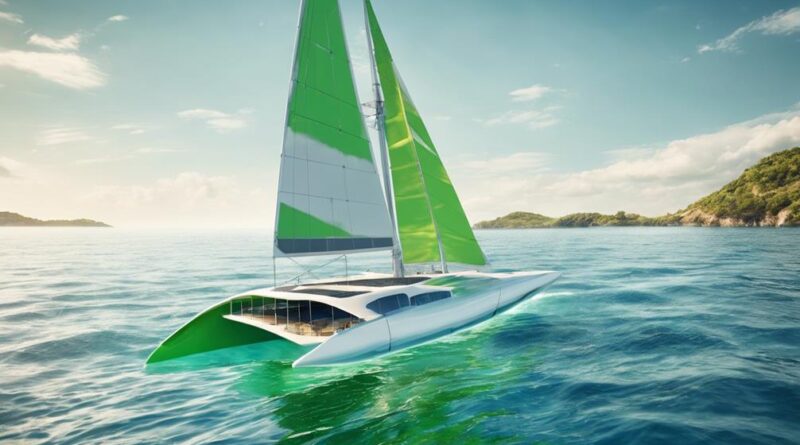Sustainable Sailboat Journeys: An Eco-friendly Adventure
Embark on a journey reminiscent of ancient seafarers, where the wind guides your sails towards sustainability. Imagine a voyage where every wave carries the promise of eco-friendly practices and conservation efforts. From harnessing renewable energy sources to engaging with local communities, each aspect of your sailboat adventure contributes to a greener tomorrow.
But how exactly can you ensure that every nautical mile leaves a positive impact on the environment? Let's navigate through the seas of sustainable sailboat journeys together, discovering the key strategies that make this eco-friendly adventure possible.
Eco-conscious Packing Tips
When preparing for sustainable sailboat journeys, prioritize eco-conscious packing to reduce your environmental impact. Opt for minimalist essentials that serve multiple purposes, allowing you to pack lighter and reduce overall waste. Choose clothing items that are versatile and made from sustainable materials to minimize your footprint. Consider packing items that can be layered for varying weather conditions, reducing the need for excess clothing.
Invest in reusable containers to store food and beverages on your sailboat. Utilizing reusable containers not only cuts down on single-use plastics but also helps keep your provisions organized and fresh. Choose containers that are durable and leak-proof to withstand the rigors of sailing. Additionally, consider bringing along a water filtration system to reduce the need for single-use plastic water bottles.
When packing toiletries, opt for solid versions of products such as shampoo bars, solid toothpaste tablets, and solid lotion bars. These items eliminate the need for plastic packaging and are TSA-friendly for air travel to and from your sailing destination. Remember to pack biodegradable soaps to ensure you aren't polluting the water while onboard.
Renewable Energy Sources Onboard
Consider integrating solar panels and wind turbines onboard to harness renewable energy sources for powering your sailboat efficiently. These sustainable options not only reduce your carbon footprint but also provide a reliable source of power during your journey. Here are some key points to keep in mind:
- Solar panels: Install solar panels on the deck or cabin top to capture sunlight and convert it into electricity. This clean energy source can help charge your batteries, run electronic devices, and even power small appliances onboard.
- Wind turbines: Mounting a wind turbine on your sailboat can also generate electricity as the wind turns the blades. This additional renewable energy source complements solar power, especially during windy conditions, providing a consistent power supply.
- Battery storage: Invest in high-quality batteries to store the energy generated by solar panels and wind turbines. Having sufficient battery capacity ensures a steady power supply, even when the sun isn't shining brightly or the wind is calm.
- Efficient energy management: Implement energy-efficient practices onboard, such as using LED lights, optimizing electronic devices' usage, and monitoring power consumption. Being mindful of energy usage prolongs battery life and maximizes the benefits of renewable energy sources.
Zero-waste Galley Practices
To further enhance your sustainable sailboat journey, implement zero-waste galley practices to minimize environmental impact and promote eco-friendly living onboard.
One key practice is composting leftovers. Instead of throwing food scraps overboard, set up a composting system on your sailboat. Collect fruit peels, vegetable trimmings, and other organic waste in a dedicated bin. This not only reduces the amount of trash generated but also creates nutrient-rich compost that can be used to nourish any onboard plants or even be disposed of safely on land during stops.
Another important step is to use reusable containers for storing food and leftovers. Invest in durable containers made of materials like stainless steel or glass that can be washed and used repeatedly. When preparing meals for your journey, opt for bulk ingredients that can be stored in these containers, reducing the need for single-use plastic packaging. This not only cuts down on waste but also keeps your food fresher for longer periods.
Marine Life Conservation Efforts
Implement sustainable practices to protect marine life while sailing, ensuring a positive impact on the ocean ecosystem. When embarking on your sailboat adventure, you have the power to contribute to marine life conservation efforts. By being mindful of your actions, you can help preserve the delicate balance of the ocean environment.
Conservation Efforts for Marine Life
- Reduce Plastic Pollution: Avoid single-use plastics onboard to prevent them from ending up in the ocean and harming marine life.
- Support Coral Restoration: Learn about coral restoration projects in the areas you visit and consider volunteering or donating to support these initiatives.
- Practice Responsible Fishing: If you engage in fishing while sailing, follow catch limits and avoid using destructive fishing methods that can harm marine ecosystems.
- Participate in Beach Clean-ups: Whenever you make landfall, take the time to clean up any trash you find on the shoreline to prevent it from entering the ocean.
Sustainable Anchoring Techniques
When anchoring your sailboat sustainably, ensure to choose anchoring locations that minimize impact on marine habitats. Eco-friendly mooring solutions play a crucial role in protecting the delicate underwater ecosystems. Opt for designated mooring areas or use eco-friendly anchors that don't damage coral reefs or disturb marine life. By practicing sustainable cruising methods, such as using anchorages with sandy bottoms instead of coral reefs, you can help preserve marine habitats for future generations.
Consider using anchor bags filled with environmentally friendly materials like sand or gravel instead of traditional anchors. These anchor bags aren't only effective in securing your sailboat but also reduce the risk of damaging sensitive marine environments. Additionally, using anchor lights powered by solar energy is a sustainable way to ensure safe anchoring without harming the marine ecosystem.
When anchoring in seagrass meadows or near coral reefs, be mindful of the potential impact on these habitats. Choose anchoring locations where the seabed is less sensitive, and avoid dropping anchor directly on top of coral reefs. By practicing responsible anchoring techniques and opting for eco-friendly mooring solutions, you can enjoy your sailboat journey while minimizing your environmental footprint. Remember, sustainable anchoring not only benefits the marine environment but also enhances the overall experience of your eco-friendly adventure.
Carbon Footprint Reduction Strategies
Considering sustainable anchoring techniques is just the beginning; now, let's explore practical strategies to reduce your carbon footprint while sailing. By incorporating green sailing practices and energy-efficient navigation, you can significantly minimize the environmental impact of your journeys. Here are four essential strategies to help you achieve eco-friendly sailing:
- Opt for Renewable Energy Sources: Install solar panels or wind turbines on your sailboat to harness clean energy for powering electronic devices and appliances. This reduces the reliance on fossil fuels and decreases emissions.
- Practice Sail Trim and Efficiency: Master the art of sail trim to maximize wind utilization and minimize the need for motor propulsion. Utilizing the wind efficiently not only reduces fuel consumption but also enhances the overall sailing experience.
- Support Carbon Offsetting Programs: Engage in carbon offsetting initiatives to counterbalance the emissions produced during your sailing trips. By investing in projects that reduce greenhouse gases, you can neutralize your carbon footprint and contribute to environmental conservation.
- Embrace Eco-Friendly Maintenance: Use environmentally friendly cleaning products and antifouling paints to maintain your sailboat. Implementing sustainable maintenance practices helps prevent water contamination and minimizes harm to marine ecosystems.
Community Engagement Initiatives

To foster a more sustainable sailing community, engage in collaborative initiatives that prioritize environmental stewardship and community involvement. By organizing beach cleanups and outreach programs, you can actively contribute to preserving the marine ecosystem and raising awareness about the importance of environmental conservation. These initiatives not only help in keeping the oceans clean but also encourage others to join in the effort towards a cleaner environment.
Partnering with sustainable tourism organizations and involving local communities in your sailing adventures can further enhance your community engagement initiatives. By forming sustainable tourism partnerships, you can promote responsible travel practices and support local economies in coastal regions. This collaboration can lead to meaningful interactions with local communities, fostering cultural exchanges and mutual learning experiences.
Engaging in community outreach programs allows you to connect with a wider audience and share the benefits of sustainable sailing practices. By actively involving local schools, environmental groups, and other stakeholders, you can inspire others to take action towards a greener future. Encouraging local involvement not only strengthens community bonds but also amplifies the impact of your sustainability efforts.
Eco-friendly Port Exploration
For a more sustainable approach to your sailboat journeys, explore eco-friendly ports that prioritize environmental conservation and support green practices. When choosing ports to visit during your sailing adventures, opt for destinations that share your commitment to protecting the environment and promoting eco-friendly practices.
Here are four key aspects to consider when exploring eco-friendly ports:
- Green Transportation: Look for ports that offer electric vehicle charging stations or have bike-sharing programs available for visitors. Choosing destinations that support green transportation options can help reduce carbon emissions associated with your travels.
- Eco-Friendly Tourism: Seek out ports that promote eco-friendly tourism activities such as guided nature walks, wildlife watching tours, or sustainable fishing excursions. These activities not only allow you to experience the natural beauty of the area but also contribute to the local conservation efforts.
- Waste Management Initiatives: Consider ports that have effective waste management systems in place, including recycling programs and initiatives to reduce single-use plastics. Supporting ports that prioritize waste reduction and recycling helps minimize the environmental impact of your visit.
- Renewable Energy Sources: Choose ports that harness renewable energy sources like solar or wind power to meet their energy needs. Ports that invest in renewable energy contribute to the overall reduction of greenhouse gas emissions and promote a more sustainable future for the maritime industry.
Frequently Asked Questions
How Can I Ensure My Sailboat Journey Is Safe for Marine Life and Ecosystems?
To make sure your sailboat journey is safe for marine life and ecosystems, focus on marine conservation and sustainable practices.
Avoid throwing trash overboard, use biodegradable cleaning products, and be mindful of your anchoring to protect sensitive habitats.
Reduce plastic waste by bringing reusable items. Respect wildlife by keeping a safe distance.
What Types of Renewable Energy Sources Are Most Commonly Used on Sailboats?
To power sailboats sustainably, sailors commonly use the following renewable energy sources:
- Wind turbines harness the wind's energy.
- Solar panels convert sunlight into power.
- Hydro generators generate electricity from the boat's movement through water.
- Biofuels offer an eco-friendly alternative to traditional fuels.
Are There Any Specific Guidelines for Disposing of Waste While at Sea?
When out at sea, it's crucial to follow specific guidelines for waste management and recycling to protect ocean conservation and prevent pollution. Proper disposal of waste is key, separating recyclables and non-recyclables.
Avoid throwing any trash overboard. Store waste securely and dispose of it responsibly when back on land.
How Can I Minimize My Carbon Footprint While Sailing?
To minimize your carbon footprint while sailing, focus on sustainable practices and eco-conscious habits. Reduce waste by using reusable items, like water bottles and food containers.
Opt for eco-friendly cleaning products to avoid polluting the water. Sail during daylight hours to rely less on engine power.
Properly dispose of any waste on land to prevent marine pollution. By adopting these practices, you can enjoy sailing while being environmentally responsible.
What Are Some Ways to Get Involved in Community Engagement Initiatives While on a Sailboat Journey?
To get involved in community engagement while on a sailboat journey, consider participating in coastal cleanups and conservation workshops. Partner with local communities for educational outreach initiatives.
Conclusion
When embarking on sustainable sailboat journeys, every small eco-friendly choice you make can have a big impact on our oceans and planet.
By packing consciously, utilizing renewable energy sources, practicing zero-waste galley habits, and engaging in marine conservation efforts, you can enjoy your adventure while minimizing your carbon footprint.
Remember, every action counts in preserving our beautiful oceans for future generations to enjoy.
Bon voyage!
